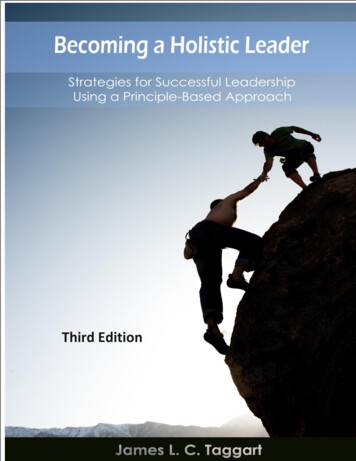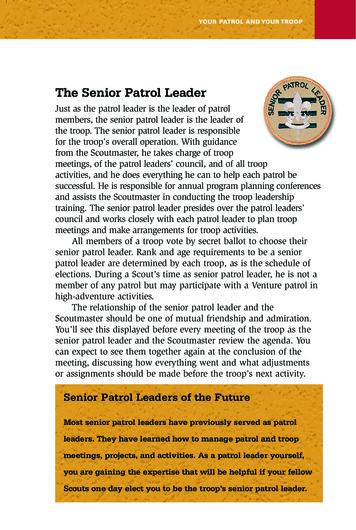
Transcription
U.S. Army Soldiers with 162nd Infantry Regiment, 41st Infantry Brigade Combat Team prepare to flip an inflatable boat during broachingrecovery training at Cullaby Lake near Warrenton, Oregon, Aug. 16, 2020. (U.S. Army photo by Maj. Leslie Reed)The Leader’s Guide to BuildingResilient SoldiersSgt. Maj. Marius OrhonU.S. Army Sergeants Major AcademyNSoldier Behavioral Health Issuesoncommissioned officers (NCOs) are critical inthe resilience-building process and developingSoldiers who can overcome adversity, cope withstressors, and help deter behavioral health risks. Unitleaders are increasingly faced with the adverse effectsof Soldier behavioral health issues because of the U.S.Army’s high operation and deployment tempo. This isnegatively affecting unit readiness. Building resiliencein Soldiers requires consistent leader engagement andlong-term innovative coping mechanisms to preventpotential behavioral health issues. This article describesthe impact of behavioral health on the force and severalstrategies a leader can implement to increase resilience intheir Soldiers.NCO JournalAccording to the Department of Defense’s (DOD)2018 Annual Suicide Report, from 2013 to 2018, thesuicide rate for the U.S. Army active component increased from 18.5 to 24.8 suicides per 100,000 servicemembers (DOD, 2019). Furthermore, Patricia Kime(2019) stated “Mental health appointments amongactive-duty troops accounted for roughly 16% of allmilitary medical appointments, or 1.8 million outpatient visits” (para. 2).These statistics show a growing decline in thebehavioral health of Soldiers and a steady increase insuicides because of it. What’s needed in today’s Soldiers is more resilience, defined by the Department of1September 2020NCO Journal provides a forum and publishing opportunity for NCOs, by NCOs, for the open exchange of ideas and information in support of training, education and ls/NCO-Journal/
(Department of the Army, 2020). NCOsdevelop their Soldiers by teaching, coaching,and mentoring their subordinates. However, building resilience in Soldiers requiresa holistic approach to Soldier developmentand leaders must recognize each Soldier isunique and will react to stressors differently.Unit leaders must possess self-awarenessand the ability to incorporate servant leaderprinciples into their leadership style to improve resilience in all Soldiers (Departmentof the Army, 2016a).Servant LeadershipServant leadership focuses on modelingethical behavior and demonstrating a genuine concern for subordinates. Ultimately, thisleadership style enables a leader to identify andU.S. Army Soldiers attending a Basic Leadership Course participate in a suicideunderstand how stressors affect each Soldierprevention course at the 7th Army Noncommissioned Officer Academy, Grafenwoehr, Germany, July 17, 2020. (U.S. Army photo by Spc. Zack Stahlberg)individually. The servant leadership style doesnot require leaders to coddle Soldiers, butthe Army (2014) as “the mental, physical, emotional,instead relies on the fundamental principles of activeand behavioral ability to face and cope with adverlistening, empathy, healing, awareness, and commitmentsity, adapt to change, recover, learn, and grow fromto the growth of people (Griffing, 2019). These principlessetbacks” (p. 6).allow a leader to influence at-risk Soldiers by interpreting verbal and nonverbal cues, empathizing withImpacts of Behavioral Health IssuesSoldier’s emotional challenges, and seeking opportunitiesAt the strategic level, Soldier suicide and behavioralto heal them from overwhelming setbacks. Furthermore,health concerns have created numerous legislative actions understanding a Soldier’s mental and emotional capato address these issues. Congress directed several manbilities allows the leader to gauge how much pressure todates in the National Defense Authorizations Act of fiscal place on a Soldier before it becomes too overwhelmingyears 2011 through 2019. These mandates have includedand negative behaviors emerge (Lampkin, 2019).establishing a task force to examine suicide prevention,developing a comprehensive suicide prevention policy,Self-Awarenessand establishing a DOD oversight committee for suicideRecognizing each Soldier possesses varying degrees ofprevention and resilience programs (Kamarck, 2019).resilience and reacts to stressors differently may require aThe psychological effects of behavioral health issuesleader to adapt their leadership approach by maintainingand/or suicide of a Soldier also affects the emotionalself-awareness. Leaders lacking self-awareness may causestability of other Soldiers, friends, and family. Accordingcounterproductive behaviors during stressful situationsto the Psychiatric Times (2018), “If the psychopathologyand add to stressors affecting their subordinates. Accordcausing these problems goes untreated, chronicity devel- ing to the Department of the Army (2019), all leaders areops that leads to significant social impairment, maritalsusceptible to displaying counterproductive leadershipdysfunction, job instability, suicide, substance abuse, and behaviors in times of stress. This may result in decreasedviolent behavior” (para. 3). Additionally, the psychophysical and psychological well-being, depression, andlogical impacts of losing a fellow Soldier may repeat theburnout. Furthermore, self-awareness is critical whencycle of behavioral health issues in other Soldiers dueattempting to provide emotional support to Soldiers withto the potential inability to cope with the loss. However,low resilience. An aggressive leadership approach withan adaptive and resilient leader can help mitigate thean overwhelmed Soldier may prove ineffective.impacts of these behavioral health issues through variousThrough self-awareness, a leader can identify personleadership approaches.al resilience shortcomings and improve through self-development. The Department of the Army (2019) stated,The Resilient Leader“In no other profession is the cost of being unpreparedNoncommissioned officers (NCO) have two prima- to lead so unforgiving in terms of mission failure andry responsibilities: the accomplishment of the mission loss of life” (p. 6-2). Self-aware leaders demonstrateand the development and welfare of their Soldiershumility and actively seek opportunities to acquireNCO Journal2September 2020NCO Journal provides a forum and publishing opportunity for NCOs, by NCOs, for the open exchange of ideas and information in support of training, education and ls/NCO-Journal/
knowledge and experience in leadership. Throughself-development and openness to feedback, a leaderwill increase their confidence and resilience to handleunseen stressors.resilience in their Soldiers. This allows leaders to utilizethe techniques commonly instructed within a classroomenvironment to Soldiers at any time. Informal TrainingMethods for Building ResilienceIncorporating resilience techniques into the daily lifeof a Soldier will rapidly accelerate the process of buildingresilience in Soldiers. According to the Department ofthe Army (2014), “Incorporating Resilience and Performance skills into scheduled and unscheduled unit activities and tailored to unit needs is the process by whichSoldiers learn how to think about and apply the trainingto themselves and others” (p. 18). To achieve a lastingeffect in building Soldier resilience, unit leaders must develop innovative methods to increase resilience-buildingopportunities for their Soldiers. Leaders can incorporatethese activities during realistic training exercises, afteraction reviews, and leader-led after action debriefs.Formal Training Methods for BuildingResilienceThe U.S. Army has many formal resilience trainingprograms to assist leaders with building resilience in Soldiers. Unit leaders can utilize current resilience trainingprograms such as the Global Assessment Tool (GAT)and the Master Resilience Training (MRT) Course. However, the main challenge with these programs is not thequality of training but rather the frequency of presentingthem to Soldiers. According to the Department of theArmy (2014), “Soldiers will not embrace training thatis merely theoretical and classroom-based; they requirerelevant and practical training they see as empowering,improving their strength, and enhancing their personalhealth and performance” (p. 18). These formal trainingprograms must support the leader’s plan of action todevelop resilience in their Soldiers and not serve as theprimary solution to Soldier development.Realistic TrainingRealistic training is the top method for developingresilience within a Soldier. “Realistic training developed around critical warrior tasks and battle drills isa primary source for the resilience and confidence tosucceed along with the ability to demonstrate grit intough situations” (Department of the Army, 2019, p.8-7). The stressors of realistic training such as environmental conditions, operational stress, enemy actions,and simulated casualties place the Soldier’s mind in theworst scenario they will face in combat. Through numerous repetitions of operating in a simulated combatenvironment, a Soldier slowly builds the resilience toovercome associated stressors. “Ultimately, this type oftraining saves lives in actual operations because unitsGlobal Assessment ToolThe GAT is an option for Soldiers who are uncomfortable with communicating stressors with unit leaders.The GAT is a secure web-based program combiningcomprehensive health and fitness metrics with survey-based questions motivating the user towards behavioral change (Department of the Army, 2014). It alsoserves as a useful tool to develop a Soldier’s self-awareness and provides opportunities to conduct self-development. However, this must not be thesole solution for building resiliencein Soldiers since the GAT removesleaders from the developmentprocess. Unit leaders must utilize theGAT as a means to enhance leadership involvement by developing theirSoldiers through effective communication.Master Resilience Training CourseThe MRT course is a 10-daycourse focusing on learning resilience competencies and skills(Department of the Army, 2014).From a leadership perspective,MRT-qualified leaders can use resilience competencies and skills andincorporate them into their leadership approach. Applying these skillswith the servant leadership approachenhances a leader’s ability to buildNCO JournalU.S. Army Soldiers with the 2d Cavalry Regiment arrive as part of the advanced echelon teamfor Noble Partner 20 in Tbilisi, Georgia, Aug. 29, 2020. (U.S. Army photo by LaShic Patterson)3September 2020NCO Journal provides a forum and publishing opportunity for NCOs, by NCOs, for the open exchange of ideas and information in support of training, education and ls/NCO-Journal/
are already familiar with the stress and demands ofthe training environment” (Department of the Army,2016b, p. A-4).Leaders who pursue this should be MRT-qualified andunderstand the servant leadership style.Resilience-Based After Action ReviewThe current after action review (AAR) methodcapitalizes on learning from mistakes conductedduring realistic training and focuses on improving theperformance of individual and collective tasks. However, there are a lack of resilience-building techniquesduring the AAR that address Soldier stressors. Leaderscan incorporate resilience-based questions that preparethe Soldier’s mind for combat stress.According to the Department of the Army (2016b),“The AAR is a guided analysis of an organization’sperformance, conducted at appropriate times duringand at the conclusion of a training event or operationwith the objective of improving future performance” (p.D-1). The AAR enables Soldiers to access what happened through self-discovery, allowing them to developa plan for improving performance. These AARs providecandid insight into a Soldier’s strengths and weaknessesfrom various perspectives and feedback.The following are two examples demonstratingresilience-based questions during an AAR: How wouldyou genuinely react if your battle buddy died next toyou and you had to continue to engage the enemy?How would you cope with the loss of a friend in combatwhile keeping focused on completing the mission?Incorporating resilience-based questions at the end ofan AAR does not negate the primary focus of the AAR,which is an assessment of the performance measuresrelated to a mission essential task, but instead widensthe scope of the AAR to improve resilience in Soldiers.Frequent deployments can be stressful. Knowing what to expectcan help prepare Soldiers and their families. (Graphic by U.S. ArmyResilience Directorate)ConclusionLeader-Led After Action DebriefThe facilitation of a leader-led after action debriefing focuses on the emotional impact of a potentiallytraumatic event. According to the Department of theArmy (2016a), “A potentially traumatic event is anevent that causes an individual or group to experienceintense feelings of terror, horror, and hopelessness” (p.7-3). This opportunity to strengthen resilience withina Soldier is essential to Soldier development since it allows the leader to mitigate any behavioral health risksimmediately. However, an unprepared leader mustuse caution when facilitating this type of debriefing toprevent additional stressors that could negatively affectSoldiers and can lead to a behavioral health issue.The U.S. Army’s operational tempo over the last 19years has taken a significant toll on its force and families causing stressors that may be effecting the mentalhealth of Soldiers. Soldier suicide rates continue to riseeach year with no definite solution in sight.The role of leaders in the resilience-building processis critical to developing Soldiers who can overcomeadversity. Unit leaders who demonstrate genuine concern and proactively train resilience in their Soldierswill mitigate behavioral health issues and possible lossof life. Ultimately, combating behavioral health issuesof Soldiers requires adaptive servant leaders who canprovide innovative resilience-building techniques totheir Soldiers.ReferencesDepartment of Defense. (2019). Annual suicide report. al%20NCO JournalSuicide%20Report FINAL 25%20SEP%2019 508c.pdfDepartment of the Army. (2014). AR 350-53: Comprehensive4September 2020NCO Journal provides a forum and publishing opportunity for NCOs, by NCOs, for the open exchange of ideas and information in support of training, education and ls/NCO-Journal/
soldier and family. s/r350 53.pdfDepartment of the Army. (2016a). ATP 6-22.5: A leader’s guideto soldier health and fitness. https://armypubs.army.mil/epubs/DR pubs/DR a/pdf/web/atp6 22x5.pdfDepartment of the Army. (2016b). FM 7-0: Train to win in acomplex world. https://armypubs.army.mil/epubs/DRpubs/DR a/pdf/web/ARN9860 FM%207-0%20FINAL%20WEB.pdfDepartment of the Army. (2019). ADP 6-22: Army leadershipand the profession. https://armypubs.army.mil/epubs/DR pubs/DR a/pdf/web/ARN20039 ADP%206-22%20C1%20FINAL%20WEB.pdfDepartment of the Army. (2020). TC 7-22.7: The noncommissioned officer guide. https://armypubs.army.mil/epubs/DR pubs/DR a/pdf/web/ARN20340 TC%207-22x7%20FINAL%20WEB.pdfGriffing, A. L. (2019). Servant leadership: Ten military figureswho got it right. NCO Journal. al/Archives/2019/April/servant-leadership/Kamarck, K. (2019). Military suicide prevention and response(CRS Report No. IF10876). Congressional Research Kime, P. (2019). Military suicide rates hit record high in2018. Military.com. n, D. (2019). The relationship between leadershipand stability. NCO Journal. berman, J. (2018). Solving the mystery of military mentalhealth: A call to action. Psychiatric Times. ery-military-mental-health-call-actionSgt. Maj. Marius Orhon is a class 70 graduate of the U.S. Army Sergeants Major Academy. He holds a Bachelor of Arts degree in leadership and workforce development from the Command and General Staff College.Orhon is currently assigned as the operations sergeant major for the 95th Civil Affairs Brigade (SpecialOperations) (Airborne) at Fort Bragg, North om/ncojournalofficial/Disclaimer: The views expressed in this article are those of the authors and do not necessarily reflect theopinions of the NCO Journal, the U.S. Army, or the Department of Defense.NCO Journal5September 2020NCO Journal provides a forum and publishing opportunity for NCOs, by NCOs, for the open exchange of ideas and information in support of training, education and ls/NCO-Journal/
action reviews, and leader-led after action debriefs. Realistic Training Realistic training is the top method for developing resilience within a Soldier. “Realistic training devel-oped around critical warrior tasks and battle drills is a primary source for the resilience and confidence











